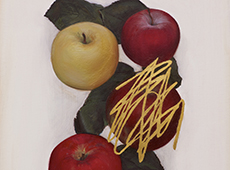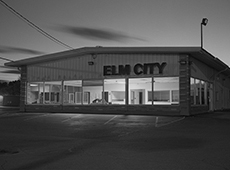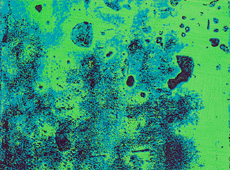We started Tilted Arc back in October because we wanted to create a conversation around ideas of practice and intention. We are so deeply grateful to the artists who have contributed fresh and often challenging insight into how art and literature get made, and the essential place that materials, memory, perception and process claim in their making. Never mind that what they’ve contributed is some of the best writing about art we’ve read. Here are some snips, excerpts that we loved reading and that have helped us in our own practice. Enjoy.
…I was reminded that what I want is to palpably feel the presence of it all as though light is weight and mass, to feel it as though it were taste or sound.
—Stuart Shils, 29 October 2013
When I made this painting it felt as if it was taking shape in my peripheral vision. It took a gentle act of will to keep it there long enough to finish it…
—Mark Wethli, 10 December 2013
Absurdity, as a concept…can transcend immediate frustration by asking the viewer to question, not only what they are seeing and feeling, but, more importantly, why they are questioning their awakened uneasiness. Hopefully, the dichotomy only increases when one is seduced by the richness of the painting’s surface and the enticing vividness of color…
—Arnold Mesches, 5 December 2013
…so much of painting is this. It’s a recalling and churning up of experience and memory that can never be planned, relied on, or trusted. But my process requires trust. I begin with random marks and colors that over time coalesce… . Little by little, the anxiety lessens as…decisions are made and options grow fewer until a painting is made.
—Paul Behnke, 26 November 2013
Art doesn’t have to explain our situation within the complexity of a chaotic and unstable society. Art can become social commentary, but it can also serve a much needed purpose, providing a place of refuge wherein one can find a reason, or justification, for all the battling we have to do, mentally or physically, most of every day of our lives.
—Alan Feltus, 17 December 2013
The ‘magic’ part, for me, happens when the ordinary gets transformed. The glass becoming talismanic – being filled like a body – the rain also, now as disease, now as God…
—Carl Phillips, 1 November 2013
The further the painter lets go of everything before they pull it back together, the more expansive the experience; and the more acceptance there is of the concept that we are part of something larger than ourselves that can be known, but not fully understood.
—Michael David, 9 November 2013
…The real question is not what do we see…but how do we see–and what is our responsibility to it in terms of what we make…
—Stuart Shils, 2 December 2013
…Each painting emerges from recollections of places seen and imagined, music and conversations heard, emotions, expectations and anticipation — all of it gets transferred onto the surface through color and structure. Painting is pulling stuff out of mental storage and adding to the supply at the same time.
—Emilia Dubicki, 2 December 2013
Since [reading the diaries], I feel less and less the need for words to accompany the process of my work, and more engaged with how the unconscious functions without them.
—Sharon Etgar, 19 November 2013
Color hits you hard. It doesn’t last as long as form, but it hits you harder.
—Sir Anthony Caro, 28 October 2013
Art should be about transcendence. It should not merely reflect our surroundings like a mirror, adding to the clutter, but become something more wonderful, more meaningful than that. It wants to be remembered and returned to over and over again. Good art feeds us. It is so important.
—Alan Feltus, 17 December 2013
A sense of tradition charges any artistic activity with meaning. Connecting art-viewers and art students to the world of artistic accomplishments that traverse centuries of human history is the central axis of art education. Any course, lecture or workshops on any subject revolves around that axis.
—Ilya Gefter, 10 October 2013
…I felt I’d gotten the light I wanted. It looked and felt like water at night. The layering and pale pink over dark purple created the effect of light bouncing off a surface and I recognized a kind of transparent glow that had happened in the course of painting the barges…
—Katherine Bradford, 18 November 2013
The work of mine I value most has often begun with a painting of this kind—a hybrid outlier, without pedigree, that proves to be the harbinger of a new body of work three or four years later. What I’ve learned over time is that for every “find,” “making a find” takes time and a kind of mindful inattention to make its way into the work. When it does, though, there is often a roomful of them before I realize it already has.
—Mark Wethli, 10 December 2013
…I tend to trust what I paint, because I don’t set out with a preconceived agenda…. I don’t think in an explicit sense when I paint. Painting is thinking.
—Karen Schwartz, 23 November 2013
Eventually a structure that pleases me starts to emerge. Sometimes shallow space, sometimes deeper space reminiscent of a landscape or an interior. I want imagery in my work to be difficult to pin down…I want the viewer to be able to enter into an open-ended dialogue with the work, the same process that brought me to its completion.
—Jay Zerbe, 4 December 2013
…sometimes what we think is the work is not the work. Peripheral influences which can arise during the making or process may contain more of a felt experience than was at prime focus.
—Vincent Hawkins, 7 November 2013
Rhythm is the visual record of transformation…The degree to which the painter is transformed by their process is the degree by which the viewer can be transformed by, or enabled to “enter,” the painting. It’s not a finite record or exchange, but in the face of that genuine and meaningful articulation of transformation, the viewer does feel it, does “know it.”
—Michael David, 9 November 2013
In working, I try to crystallize all of my ideas, observations and impressions about line, architecture, color and geometry. At the same time, I try to keep the result open ended, so that the viewer can bring their own thoughts, and reinterpret their own experiences, to find that sensation of place that we hold in common.
—Elizabeth Gourlay, 16 December 2013
I have witnessed the utter transformation of what was once primarily a world of small towns and countryside into one of ever expanding networks of expressways, corporate centers and big box distribution centers. My work is informed, directly or indirectly, by these highly disorienting places. What I see are entirely new kinds of landscapes–highly engineered and intensely geometricized.
—Steven Baris, 7 December 2013
The generosity of the medium, as Lee Friedlander would later put it, describes the chaos of the backstage scene and its attending excitement: note the missing bulb over the mirror, the awkwardness of Andy shaking hands…
—Gary Green, 31 October 2013
I wait and watch for a scene to develop…a moment which stops time and presents a question or mystery. How does a young girl know the posture for a violent act?
—Karen Keating, 6 December 2013
The spectacle we all saw on TV of ruined homes and homeowners, a somber-faced reporter asking someone who lost her home or, in too many cases, a loved one, ‘how do you feel?’—it was just was too much for me…. What I needed was a stand-in for the people who had lost so much—a symbol or, better, a metaphor.
—Stan Strembecki, 24 October 2013
Psychology often follows hard facts of the physical world—when your house is built with water a few feet below ground, and there are shells pressing it back, and you look through your cracked floorboards and can see the shells because your house is raised a foot off ground…
—Katie Ford, 21 October 2013
These paintings operate at a critical intersection of my own biography, my personal obsessions and a very significant turning point of the American landscape. I can only hope that the formal language of this work is adequate to these truly unprecedented spatial experiences.
—Steven Baris, 7 December 2013
Japan has for decades been a spiritual home to me. I wanted to offer whatever meager support I could and bear witness to tragedy as I would [for] a close friend. I think my photographs [from Japan] were an attempt to allow others to bear witness and find a connection to the people who survived the tsunami beyond the hysteria of a 24 hour news cycle.
—Magdalena Solé, 13 November 2013
The print—naked without the frame and the context of a formal space surrounding it—quickly succeeds or fails. Instead of looking at a great Robert Adams photograph, I’m simply looking at a print on a table, in the exact same way that I look at my own work, scrutinizing for flaws and moments of salvation.
—Lauren Henkin, 14 October 2013
Editor’s Note:
Up next week: A look back at some of the best shows of 2013 and a glimpse at what we’re looking forward to in 2014. Then we’re on hiatus, dedicating some much needed and overdue studio time. We’re back in February, with more Backstories, Women in the Landscape, essays on drawing, notes on criticism, and a new feature, Art and Space–interviews with leading architects who have designed some of the most intriguing spaces for art. Stay tuned.
Subscribe to Tilted Arc
If you like this story, please consider subscribing. We are sticklers for privacy.
We will never sell or share your e-mail address.



